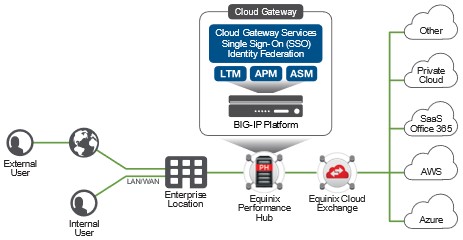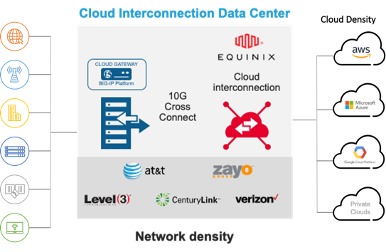すべてを安全に守る 1 つのゲートウェイ
ペルシャ門、紀元前330年
テルモピュライの峠、紀元前480年
スターリングの橋、1297年
Equinix Cloud Exchange Fabric® 、2020年
多くの場所は、何らかの重大な出来事において戦略的な役割を果たしたことにより、歴史に刻まれています。 テルモピュライの峠は、レオニダス王の有名な 300 人のスパルタ軍が進軍するペルシャ軍を食い止めた場所として記憶されています。 スターリング橋は、ウィリアム・ウォレス率いるスコットランドの抵抗とイングランド軍に対する見事な勝利と切っても切れない関係にあります。 あまり知られていないのはペルシア門で、アリオバルザネスとその軍隊がアレキサンダー大王を丸一ヶ月間抑え込んだ場所です。 目的のリソースへの単一のアクセス ポイントを制御することの戦略的な利点はよく理解されています。
利点は防御だけではありません。侵入ポイントを慎重に制御することで、防御側の有効性が何倍にも高まります。 したがって、これらの原則がデジタル セキュリティの世界で頻繁に適用されるのも不思議ではありません。
これまで長い間、組織はアプリケーションとワークロードをパブリック クラウドに移行し、柔軟性や経済効率などのデジタル変革のメリットを享受してきました。 しかし、オンプレミスのアプリケーションと同様に、クラウド アプリケーションにも、セキュリティ、負荷分散、高可用性などの高度なサービスが必要です。 さらに、データセンター インフラストラクチャにクラウド環境を追加すると、管理上の問題、コンプライアンス リスク、ポリシーの一貫性に関連する問題が発生します。
現在、 Equinix Cloud Exchange Fabric (ECX Fabric®) は、組織がこれらの課題に対処するために真剣に検討すべき場所です。 Equinix は、インターネットとほとんどの主要クラウド プロバイダー間のデジタル ブリッジとして、すべての主要な SaaS、IT サービス プロバイダー、パブリック クラウドへのアクセスを制御し、エントリを保護し、アプリケーションを保護するための戦略的な場所を提供します。
しかし、適切な場所を選ぶことは戦いの半分にしか過ぎません。 避けられない攻撃から身を守るためには、依然として防御者が必要です。 これが、アプリケーションとリソースの分散がますます多様化することで、セキュリティ専門家にとって課題が生じる主な理由です。 ほぼすべての組織は、複数のパブリック クラウドにわたってアプリケーションを運用し、かなりの量の SaaS アプリケーションを使用しています。
アプリケーションとそのインフラストラクチャを防御および保護するために必要なすべてのセキュリティ サービスを検討してください。
- アクセスを制御するためのシングルサインオン(SSO)とクラウドフェデレーション
- 消費者と企業のデータを保護し、不正使用を防ぐ双方向ウェブアプリケーションファイアウォールサービス
- SSLオーケストレーションとコンテンツ検査によりプライバシーを確保し、埋め込まれた悪意のあるデータから保護します。
- アプリケーションの可用性を維持するためのDDoS保護
各場所の各アプリケーションに対してこれらの防御者を展開すると、ソリューションの無秩序な増加とオペレーターの過負荷が発生します。 それら全体で同じレベルのセキュリティを確保することは、新たな攻撃や新たに発見された脆弱性により、常に繰り返されるタスクです。 もちろん、より良いアプローチは、トラフィックのフローを単一のゲートに強制的に通し、複数のセキュリティ サービスを展開して、すべてのクラウド プロパティにわたるすべてのアプリケーションを保護することです。
ECX ファブリックに BIG-IP プラットフォームを導入すると、複数のクラウド プロパティに展開されたアプリケーションを保護するために必要なセキュリティ サービスを単一の戦略的な場所で導入、運用、管理できるようになります。 すべてのトラフィックを同じ戦略的な場所に誘導することで、展開および維持するポリシー、運用および管理するサービス、防御するエントリ ポイントが少なくなります。
マルチクラウド企業に関連する複雑さを軽減するだけでなく、組織はエンタープライズ グレードのセキュリティを維持しながら、大幅なコスト削減とアプリケーション パフォーマンスの向上を実現できます。 また、パブリック クラウドとプライベート企業ネットワーク間の入口と出口が 1 つになることで、ネットワークとアプリケーションのセキュリティを厳密に制御しやすくなります。
このタイプの展開によく使用される F5 アプリケーション サービスには、次のものがあります。
- ローカルおよびグローバルトラフィック管理
- アクセス管理
- アイデンティティフェデレーション
- 高度な Web アプリケーション ファイアウォール (WAF)
- DDoS 保護
- SSL 検査とオーケストレーション
- テレメトリストリーミング
さらに、Equinix は、一部の F5 アプリケーション サービスと密接に連携するSmartKey ™ というサービスを提供しています。 Equinix SmartKey は、F5 が独自のセキュリティ サービスと機能を最適化するために使用する、安全なキー管理および暗号化サービスを提供するためにサービスとして提供される専用のハードウェア セキュリティ モジュール (HSM) です。
マルチクラウドの現実は、企業がさまざまな場所にあるアプリケーションを保護し、データを守るという課題に引き続き直面することを意味します。 BIG-IP プラットフォームと ECX Fabric を組み合わせることで、組織はマルチクラウド セキュリティの管理に伴うコストと複雑さを軽減しながら、攻撃者に対して戦略的優位性を獲得できます。
Equinix 環境で F5 ソリューションを採用すると、多くの利点があります。 最初に見逃してしまった場合は、さらに詳しく知るために次のリソースを確認してください。


